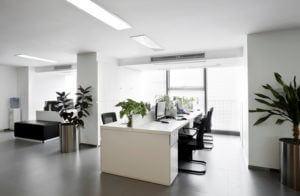 Office spaces are transforming at a rapid pace. From what used to look like a perimeter of private offices surrounding cubical farms in the middle, today businesses are moving to more open-office plans. These modern office spaces require different considerations for corporate HVAC system design.
Office spaces are transforming at a rapid pace. From what used to look like a perimeter of private offices surrounding cubical farms in the middle, today businesses are moving to more open-office plans. These modern office spaces require different considerations for corporate HVAC system design.
To keep up with the modern employee, many perimeter offices are disappearing to allow for more natural light, cubicles are being replaced with other collaborative workstations and amenities like fitness centers and open lounge space are popping up everywhere. As designs shift, corporate HVAC system design strategies must take these into consideration to maximize employee comfort and productivity.
1. Maximize Energy Efficiency with Space Designs in Mind
Commercial HVAC systems consume more energy than any other part of a building space. Therefore, for any renovations or new construction, it’s important to design the space to keep HVAC loads low and save on energy costs. Consider adding more daylight which not only boosts workplace health but also reduces heating needs in the winter. And to keep cooling loads lower in the summer and avoid solar gain, consider using a tinted low-e glass.
2. Calculate the Proper Size and System Design
Bigger is not always better, especially when it comes to corporate HVAC system design. Air conditioning equipment that’s too large, for example, will constantly turn on and off, wasting energy. Plus, since it is never running long enough to remove humidity, it creates uncomfortable, clammy conditions.
To avoid installing an oversized (or undersized) unit, businesses must calculate load requirements and take into consideration the building’s energy efficiency features, not just square footage. Because businesses must account for all patterns that will impact heating and cooling loads including building materials, lighting design, daylight and activity, it is wise to consult with HVAC experts early in the design process.
3. Control Different Areas with Zones
To boost energy efficiency and comfort, a building’s HVAC design should be able to control different areas with independently-controlled zones. Even in modern open-office space, perimeter spaces should be controlled separately than interior areas. Additionally, some areas of a building, such as the computer room or conference space, will have special temperature and humidity requirements; these must also be controlled independently.
4. Integrate Smart Technology
Smart technology for office spaces have come a long way in recent years. Sensor technology, in particular, have been useful to integrate with corporate HVAC system design to save energy. Light sensors, for example, can sense daylight in the office space and adjust lighting as necessary. These sensors can connect with the HVAC to also adjust heating and cooling needs as well. And smart occupancy sensors are able to detect how many people are using a space and adjust the temperature accordingly.
Corporate HVAC System Design and Energy Usage Services by KMB
At KMB, our philosophy is first to understand, then provide appropriate solutions and designs to help businesses create operations that are more efficient. Whether you’re looking to cut costs and improve energy efficiency in an office building, restaurant or airport, we can create an energy solution that’s specific to your needs. Contact us today to learn more about your building’s energy usage analysis at 855-75-KMBDG (855-755-6234).